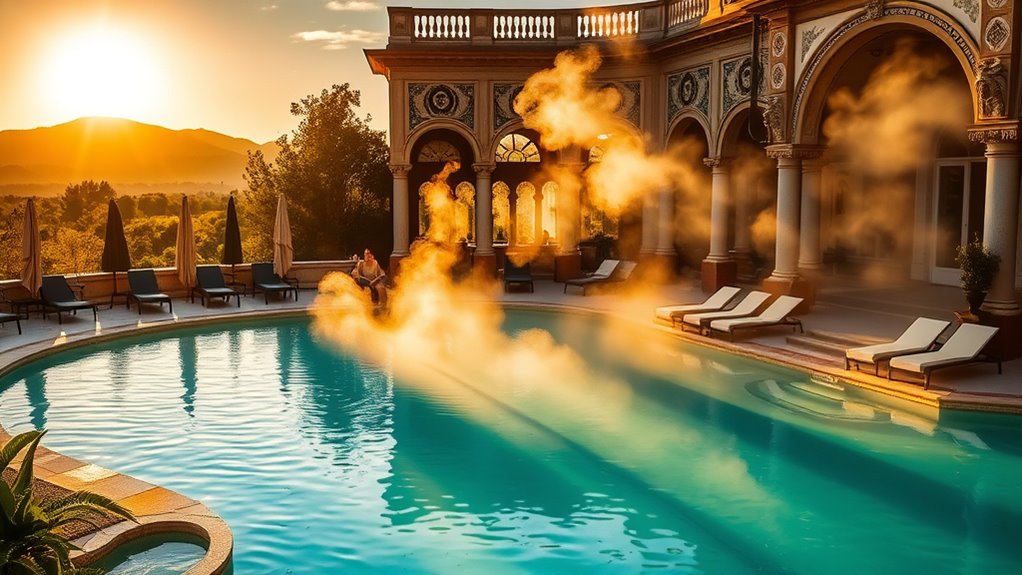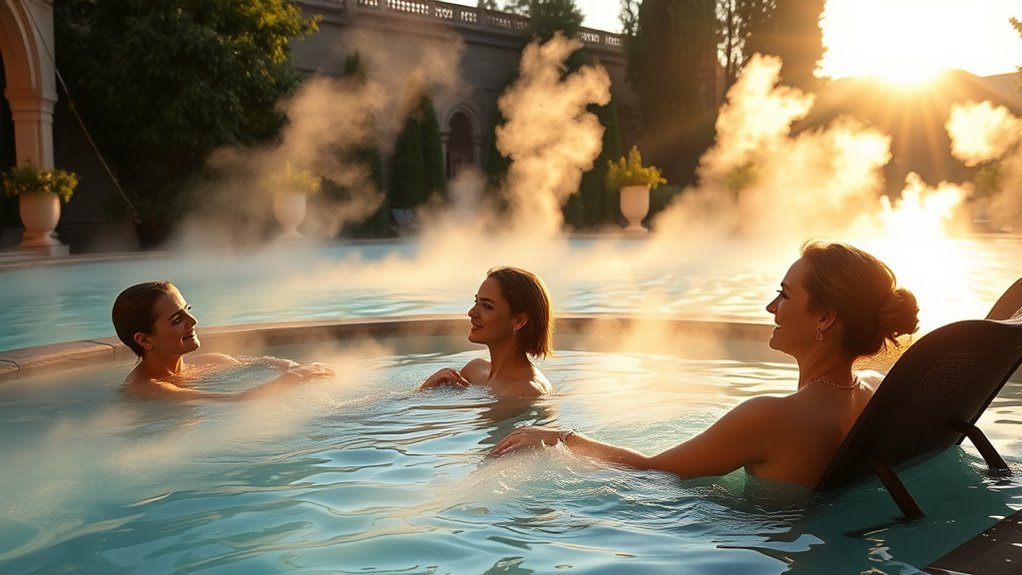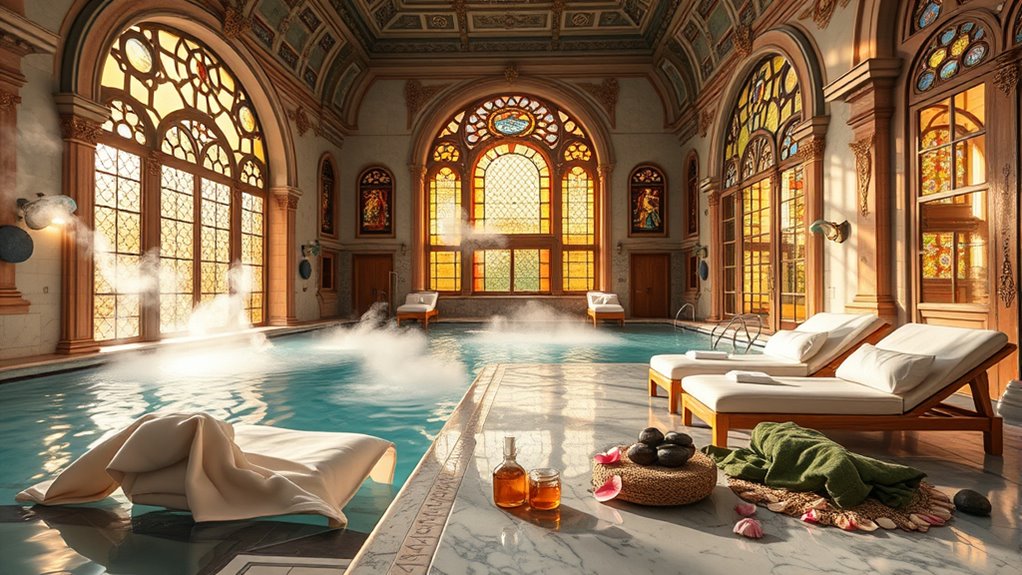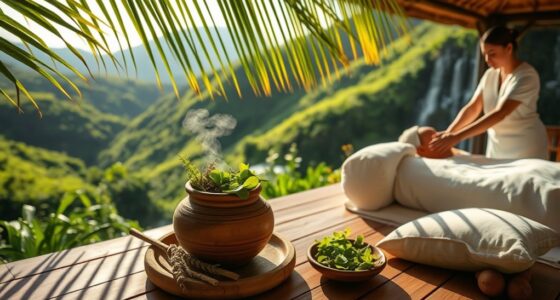Hungary’s thermal baths offer you a luxurious escape filled with history and relaxation. You can explore iconic spots like Széchenyi and Gellért, or venture beyond Budapest to hidden gems like cave spas and thermal lakes. With mineral-rich waters known for therapeutic benefits, these baths rejuvenate your body and mind. The stunning architecture and serene atmosphere enhance your experience. If you want to know more about what to expect and planning tips, just keep going!
Key Takeaways
- Hungary’s thermal baths offer a rich history dating back to the Roman era, enhancing the luxury experience with cultural significance.
- Iconic bathhouses like Széchenyi and Gellért showcase stunning architecture and provide luxurious amenities for relaxation and socializing.
- Visitors can enjoy unique experiences at cave spas in Miskolctapolca and thermal lakes in Hévíz, emphasizing luxury and rejuvenation.
- The mineral-rich thermal waters offer therapeutic benefits, relieving ailments and promoting overall well-being, enhancing the luxury spa experience.
- Planning visits during off-peak hours ensures a more tranquil and enjoyable experience in Hungary’s luxurious thermal baths.
The Rich History of Thermal Baths in Hungary

As you explore Hungary, you can’t help but notice the deep-rooted history of thermal baths that dates back nearly 2,000 years to the Roman era. The Romans established bathhouses in places like Aquincum, introducing a culture of thermal bathing that still thrives today. During the Ottoman occupation, this tradition expanded with the construction of Turkish-style baths, such as Rudas and Király. You’ll find many of these historical baths still operational, blending therapeutic benefits with rich architectural heritage. With over 1,300 natural thermal springs across the country, Hungary’s landscape is a haven for bath enthusiasts. The mineral-rich waters have shaped a unique spa culture that continues to attract visitors, providing relaxation and a glimpse into Hungary’s fascinating past. One of the largest spa complexes in Europe, the Széchenyi Thermal Bath, exemplifies this rich tradition and offers modern amenities alongside its historical significance.
Iconic Thermal Baths in Budapest

When you think of Budapest, the iconic thermal baths immediately come to mind, each offering a unique blend of history, architecture, and relaxation.
Széchenyi Baths dazzles with its Neo-Baroque design and expansive outdoor pools, making it a lively spot for socializing.
Gellért Thermal Baths impresses with stunning Art Nouveau architecture and a luxurious atmosphere.
For breathtaking views, head to Rudas Baths, where the rooftop pool lets you soak in the skyline.
Lukács Thermal Baths provides a peaceful retreat favored by locals, while Palatinus Baths offers a scenic escape on Margaret Island.
Each bath not only invites relaxation but also connects you to Budapest’s rich cultural heritage and therapeutic benefits.
Unique Experiences Beyond Budapest

While Budapest’s thermal baths are renowned, exploring the unique thermal experiences in the Hungarian countryside reveals hidden gems that offer a different kind of charm.
You’ll find thermal baths nestled in stunning natural settings, like the cave spas of Miskolctapolca, where you can soak in mineral-rich waters surrounded by breathtaking rock formations.
Eger boasts century-old Turkish baths that transport you back in time. Meanwhile, Hévíz features a vast thermal lake, perfect for relaxation.
Each region presents its own specialties, from the cascading baths of Demjén to the expansive Hajdúszoboszló complex.
These destinations not only provide rejuvenation but also showcase Hungary’s rich history and natural beauty, making them must-visit spots for any thermal bath enthusiast.
Architectural Marvels of Thermal Baths

The architectural marvels of Hungary’s thermal baths reflect a rich tapestry of history and design, captivating visitors with their grandeur.
You’ll find influences from the Roman era, Ottoman hammams, and Austro-Hungarian palaces all coexisting harmoniously. Each bath offers a unique style; for instance, Széchenyi’s Neo-Baroque design exudes opulence, while Gellért enchants with its intricate Art Nouveau details.
Hungary’s thermal baths harmoniously blend Roman, Ottoman, and Austro-Hungarian influences, each showcasing a distinct architectural style.
Rácz Thermal Bath showcases traditional Turkish architecture, complete with domed ceilings. Many baths have undergone thoughtful renovations, blending modern elements like glass facades with their historical charm.
As you explore these stunning structures, you’ll appreciate not just their beauty but also the cultural significance they hold, serving as timeless reminders of Hungary’s diverse architectural heritage.
Therapeutic Benefits of Thermal Waters

As you immerse yourself in Hungary’s thermal waters, you’ll discover a wealth of therapeutic benefits that can enhance your well-being.
These mineral-rich waters provide relief from orthopedic disorders like rheumatism, easing inflammation and improving joint mobility. The warm water relaxes your muscles and boosts circulation, offering natural pain relief.
Minerals such as sulfur and magnesium work wonders for chronic pain management, promoting relaxation and reducing stress.
Additionally, thermal waters support skin health by hydrating and soothing conditions like eczema. Improved blood circulation ensures efficient oxygen flow, while the warmth aids detoxification, reducing blood pressure and enhancing cardiovascular health.
Luxurious Spa Treatments and Services

Immersing yourself in Hungary’s thermal baths not only provides therapeutic benefits but also opens the door to a world of luxurious spa treatments and services.
At Gellert Spa, you’ll find a variety of massages, but make sure to book in advance for the most popular options. While some treatments, like mud packs, may no longer be available, others, including facial treatments and sauna experiences, await you at Szechenyi Baths.
Discover a range of massages at Gellert Spa, but remember to book early for the most sought-after treatments.
Enjoy the elegant ambiance of Gellert’s Art Nouveau architecture or the modern wellness section at Rudas Baths. For a unique experience, consider bath and dine packages.
With advanced booking highly recommended, you’ll ensure a seamless and indulgent visit to Hungary’s finest thermal spas.
Cultural Significance of Bathing in Hungary

While exploring Hungary’s rich cultural tapestry, you’ll discover that bathing holds a unique and significant place in daily life. Dating back to the Roman era, the tradition of using thermal waters for healing has evolved into a cherished social activity.
The Ottomans introduced hammam-style baths, enriching the country’s bathing practices and turning them into community hubs where friends and families gather. With mineral-rich waters providing health benefits, these baths promote both relaxation and wellness.
You’ll also appreciate the stunning architectural styles, from Art Nouveau to Neo-Baroque, that define many historic bathhouses. The blend of history, health, and social interaction makes bathing an integral part of Hungarian culture, inviting you to connect with the past and the community.
Accessibility and Visitor Information

How can you make the most of your visit to Hungary’s thermal baths? Start by choosing the right location.
Széchenyi Baths is easily accessible via the Millennium Underground, while Gellért Baths can be reached by tram. If you prefer a more serene setting, Lukács Baths and Rudas Baths offer great experiences on the Buda side of the Danube. You can also find private spas at Aquincum and Thermal Hotel Margitsziget.
Most baths operate from early morning until evening, so check specific hours—like Széchenyi’s 10 p.m. closing time.
Although public transport options are plentiful, parking may be limited. For those with special needs, some baths provide accessibility features, and many offer multi-language support to enhance your visit.
Enjoy the luxury!
Events and Activities at Thermal Baths

What events can you expect at Hungary’s thermal baths? Throughout the year, you’ll find a vibrant mix of activities.
On March 22nd, Budapest celebrates World Water Day with guided tours and mineral water tastings at popular spots like Széchenyi and Gellért Baths.
Summer brings lively bath parties featuring live DJs, themed festivities, and delicious local food, perfect for enjoying the outdoor pools.
Each season offers unique experiences, from festive winter decorations to relaxed autumn harvest themes.
Additionally, wellness initiatives like yoga sessions and holistic workshops focus on relaxation and health benefits.
With each visit, you’ll appreciate the cultural significance of these historic baths while enjoying fun and rejuvenating activities.
Planning Your Thermal Bath Experience

When should you plan your visit to Hungary’s thermal baths for the best experience? Aim for weekdays or early mornings to avoid crowds and enjoy a peaceful soak.
Winter is magical with steam rising in the chill, while summer attracts more visitors. Check the official website for specific opening hours, as they vary by bathhouse.
Winter’s enchantment unfolds with steam rising in the cold, while summer brings bustling crowds. Always check bathhouse hours online!
Don’t forget essential items: bring your bathing suit, towel, and flip-flops, as rentals aren’t available. If you’re planning to swim laps, a swim cap is mandatory.
Consider night visits, as some baths offer extended hours on weekends. Each bath, like Széchenyi or Gellért, has its unique charm, so explore and find your perfect spot!
Frequently Asked Questions
What Should I Bring to a Thermal Bath Visit?
When you visit a thermal bath, make sure you pack essential items for a comfortable experience.
Bring your swimwear, whether it’s a bikini, one-piece, or burkini.
Don’t forget a personal towel, as rentals mightn’t be available.
Flip flops or slippers are a must for hygiene, and if you forget them, you can buy a pair on-site.
Lastly, pack your own soap and shampoo, since complimentary options usually aren’t provided.
Are Thermal Baths Suitable for Children?
Thermal baths can be suitable for children, but there are some age restrictions you should know about.
Generally, kids under 14 aren’t allowed due to safety concerns, although some exceptions exist. For instance, younger children can visit specific outdoor pools with supervision.
If you’re planning a family outing, consider family-friendly places like Palatinus or Csillaghegy, which offer fun options like cold water pools and slides for your little ones to enjoy.
Can I Drink Alcohol at the Thermal Baths?
Yes, you can drink alcohol at the thermal baths, but there are rules.
You’ll find beers and wines available for purchase, but you can’t bring your own. Enjoy your drinks in plastic cups to keep things safe, and remember to drink responsibly.
You’ll need to be over 18 to indulge, as unruly behavior isn’t tolerated. Stay hydrated, as the heat can make alcohol affect you more quickly.
Are There Any Dress Codes for Thermal Baths?
Yes, there are dress codes for thermal baths. You can’t wear street clothes or be nude; swimwear is a must.
Stick to bikinis, one-piece swimsuits, tankinis, or swim shorts. For men, swim trunks or briefs are common options.
Don’t forget flip-flops for hygiene, and while swim caps are needed in swimming pools, they’re not required in thermal pools.
Lightweight cover-ups are fine for comfort between dips, so dress accordingly!
How Long Should I Stay in the Thermal Waters?
Ever wondered how long is long enough to unwind?
You should aim to spend at least 2 to 3 hours in the thermal waters. This time allows you to explore various pools and saunas fully.
If you’re keen on spa treatments or want to avoid crowds, consider extending your stay. Remember, the longer you’re there, the more rejuvenated you’ll feel.
Plus, don’t forget to savor the ambiance and tranquility around you!
Conclusion
As you explore the thermal baths in Hungary, you’ll not only indulge in luxury but also immerse yourself in a rich cultural tradition. Did you know that Hungary has over 1,500 springs, making it one of the countries with the highest number of thermal waters in the world? This unique resource enhances your bathing experience, providing therapeutic benefits and a connection to centuries of history. So, soak in the warmth and let the waters rejuvenate your body and spirit!









